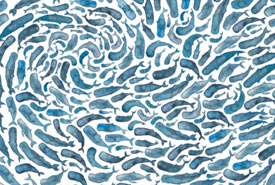An ode to whale (Part One)

Sperm whales (Illustration by Elena O'Neill)
royalty’s fish /
radiating into the night /
to fathoms and float /
(Inspired by Moby Dick)
Facts:
I’ve been reading Herman Melville’s Moby Dick during my lunches. Needless to say, this book is markedly different from my usual reads: John Grisham’s binge-worthy lawyer escapades and Lucy Maud Montgomery’s romantic chronicles.
This next series of posts will embrace whales. Herman referred to them as leviathans — mythical sea monsters of enormity.

Sperm whale (Photo from Wikimedia Commons)
Let’s start with Moby Dick himself, the sperm whale. The species' name refers to its giant forehead. There are many fascinating aspects to this aquatic goliath, including its highly sought-after vomit, curious sleeping habits, unexpected sociality, finesse for ramming its head into things and interactions with plastic pollution.
I am going to focus on spermaceti — the liquid wax inside the sperm whale’s massive noggin. Spermaceti, awkwardly mistaken for whale semen, is contained within the spermaceti organ.
For 18th century whalers, spermaceti meant money. Gallons of the “headmatter” would be harvested from a sperm whale, processed and sold. The most influential use of spermaceti was producing light. The oil component of spermaceti was used as a fuel for lamps. The wax component was formed into candles that burned longer, cleaner and brighter than beeswax candles.
However, fuel and candles were limited to the wealthy who could afford them. Fuel and candle production was an astoundingly laborious process, from whale capture and spermaceti extraction to oil separation spanning multiple months. Toilsome production kept the price of these commodities high.
For the whales themselves, spermaceti means messaging. In the 1970s spermaceti was first hypothesized to have a role in echolocation — the way by which toothed whales (or odontocetes) communicate. Since then, scientists have gathered evidence to suggest that indeed the spermaceti organ serves as an echo chamber for the clicking sounds sperm whales make to say hello.
This post orginially appeared on Natalie's blog, Phish Doc.


